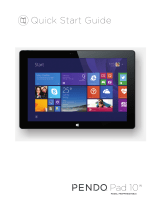
More HP resources
You have already used Setup Instructions to turn on the computer and locate this guide. To locate
product details, how-to information, and more, use this table.
Resource Contents
Setup Instructions
●
Overview of computer setup and features.
Windows 8 Basics guide
●
Overview of using and navigating with Windows® 8.
Help and Support
To access Help and Support, from the Start screen
type h, and then select Help and Support. For U.S.
support, go to
http://www.hp.com/go/contactHP. For
worldwide support, go to
http://welcome.hp.com/
country/us/en/wwcontact_us.html.
● A broad range of how-to information and troubleshooting tips.
Safety & Comfort Guide
To access this guide, from the Start screen, type
support, select the HP Support Assistant app,
select My computer, and then select User guides, or
go to
http://www.hp.com/ergo.
●
Proper workstation setup.
●
Guidelines for posture and work habits that increase your
comfort and decrease your risk of injury.
● Electrical and mechanical safety information.
Worldwide support web page
To get support in your language, go to
http://welcome.hp.com/country/us/en/
wwcontact_us.html.
●
Online chat with an HP technician.
●
Email support.
●
Find support telephone numbers.
●
Locate HP service center locations.
Regulatory, Safety and Environmental Notices
To access this guide, from the Start screen, type
support, select the HP Support Assistant app,
select My computer, and then select User guides.
●
Important regulatory notices.
Limited Warranty*
To access this guide, from the Start screen, type
support, select the HP Support Assistant app,
select My computer, and then select Warranty and
services, or go to
http://www.hp.com/go/
orderdocuments.
● Specific warranty information about this computer.
*You can find the expressly provided HP Limited Warranty applicable to your product located with the user guides on your
computer and/or on the CD/DVD provided in the box. In some countries/regions, HP may provide a printed HP Limited
Warranty in the box. For countries/regions where the warranty is not provided in printed format, you may request a printed
copy from
http://www.hp.com/go/orderdocuments or write to:
● North America: Hewlett-Packard, MS POD, 11311 Chinden Blvd., Boise, ID 83714, USA
●
Europe, Middle East, Africa: Hewlett-Packard, POD, Via G. Di Vittorio, 9, 20063, Cernusco s/Naviglio (MI), Italy
●
Asia Pacific: Hewlett-Packard, POD, P.O. Box 200, Alexandra Post Office, Singapore 911507
When you request a printed copy of your warranty, please include your product number, warranty period (found on your
service label), name, and postal address.
IMPORTANT: Do NOT return your HP product to the addresses above. For U.S. support, go to
http://www.hp.com/go/
contactHP. For worldwide support, go to http://welcome.hp.com/country/us/en/wwcontact_us.html.
2 Chapter 1 Starting right




















